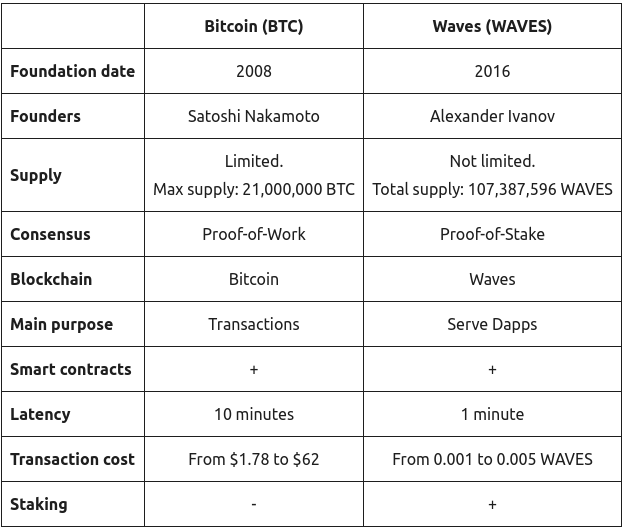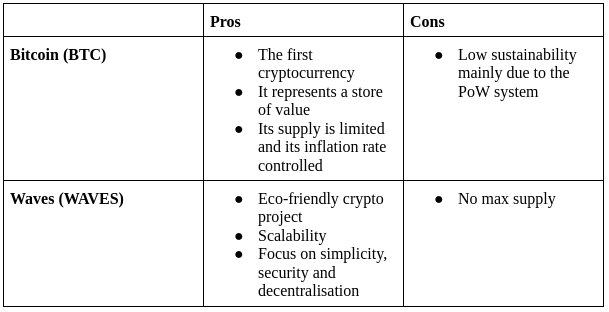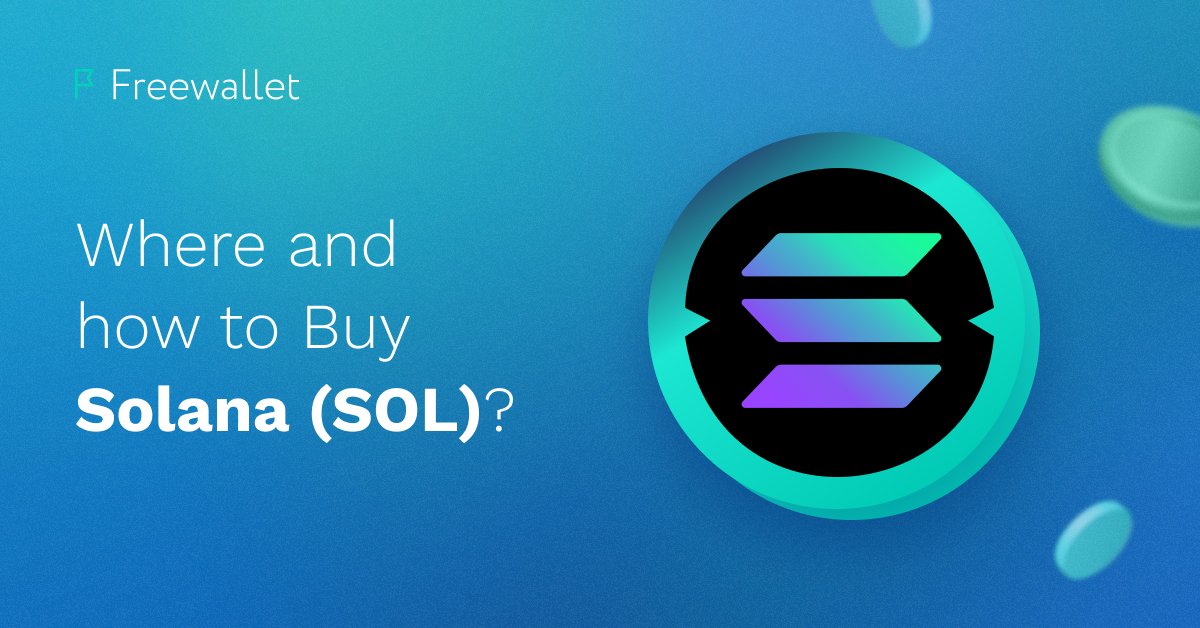
In this Bitcoin vs. Waves comparison we want to analyze two crypto projects that could set records — but for different reasons.
Bitcoin is the most popular crypto in the world: it is the first crypto, it was created to give people a kind of control over their financial future that governments were not able to provide — in fact, the year in which Bitcoin was born is not casual.
Waves, on the other hand, was created by another visionary person who wanted to improve and expand this kind of control and freedom.
We want to cover this Bitcoin vs. Waves comparison because these two projects are extremely interesting, similar when it comes to the ideology behind them, but totally different in their characteristics.
In this article we will cover all the most important features of these crypto projects, to give you detailed information about two cryptocurrencies with extremely different goals.
Bitcoin Vs. Waves: summarizing the core differences between two crypto projects

Bitcoin is considered the first cryptocurrency. Created by an unknown person or group called Satoshi Nakamoto, this cryptocurrency was inspired by the cyberanarchism ideology, which wanted to protect people’s data in a time when online transactions were becoming more popular.
What is Bitcoin (BTC)?
Even if we don’t know who Satoshi Nakamoto is, many analysts think he was a member of the Cypherpunks movement, a group whose goal was to protect privacy.
Bitcoin was created and launched during one of the worst economic and financial crises the world has ever witnessed, to give people an alternative to control their financial future.
If at its launch Bitcoin cost a few cents, people rewarded this revolutionary payment method by investing in it: in 2021 the crypto reached its all-time high surpassing $65,000 on November 8th.
What is Waves (WAVES)?
The Waves project is totally focused on security and sustainability.
In this Bitcoin vs. Waves comparison, it is worth noting that the two projects are completely different in this sense: if one of the main cons of Bitcoin is that its production is too expensive in terms of resources, Waves wants to be absolutely eco-friendly.
This cryptocurrency has many use cases — in general, it can be used for every project that needs security and speed, like DApps, gaming platforms, NFTs, and every project related to decentralized finance (Defi).
In November 2019 WAVES experienced a fall in price, maybe as a market reaction to the Waves community decision to eliminate the fixed supply of the crypto.
Bitcoin Vs. Waves: a detailed analysis of the most significant parameters
Let’s analyze in detail the parameters we mentioned in our first comparison table.
Foundation date
Both these cryptos set records: Bitcoin was the first cryptocurrency — previous similar ideas were not effectively realized; Waves launched one of the first ICOs in 2016.
Founders
As we mentioned, we don’t know who Satoshi Nakamoto is, but we can safely suppose that he is one of the Cypherpunks. Moreover, Satoshi is the founder of the most famous crypto forum, Bitcoin Talk, where terms like HODL first appeared.
Alexander Ivanov – also known as Sacha Ivanov – is a visionary tech entrepreneur who was involved in the crypto space even before the launch of Waves – he also created an early version of stablecoin, CoinoUSD.
Supply: what’s the difference between total and max supply?
As we mentioned, like Bitcoin, the Waves project originally involved a fixed maximum supply of WAVES. But in 2019 the community involved in the Waves project voted to eliminate the max supply: even if at the time of writing (February 2, 2022) the circulating supply of WAVES corresponds to its total supply, other WAVES can be created.
Consensus mechanism
The main idea of Satoshi Nakamoto was to create a payment method that would increase its value over time: Proof-of-Work serves the purpose, mixed with the limited supply, because not only it won’t be possible to mine other Bitcoins once 21 million BTC are reached, but as we approach the limit the mining process becomes harder.
On the other hand, crypto whose purpose is the creation of applications — so, a higher number of transactions — needs a faster and easier mechanism: Waves uses a particular Proof-of-Stake mechanism called Leased PoS, which allows even faster transactions.
Blockchain
Both projects have their own blockchain — of course since their purposes are different the Waves blockchain is more suitable to support faster transactions and smart contracts.
Bitcoin Vs .Waves — comparison of their main purposes
Bitcoin was born as an alternative payment method, but when Waves was launched Defi was already born, and crypto projects were finding new ways to improve what Bitcoin had started.
The purpose of Waves is to allow developers to create new applications in an easy way, to guarantee security, and reduce costs — in fact, differently from projects like Ethereum, fees are fixed, so those who create with Waves can better manage their finances.
Smart contracts
Bitcoin wasn’t born to create smart contracts, so it is not so efficient for developers — even if the Taproot upgrade reduced the impact of this limit.
For what concerns Waves, smart contracts are what allows the creation of DApps with Waves, so the project fully supports them and tries to create a better environment for them.
Latency
Being the purposes of these two projects different, Waves was realized to have a significantly lower transaction settlement time than Bitcoin — even if WAVES is not the cryptocurrency with the lowest latency.
Transaction cost
The same work for transaction costs, even in this case they had to follow the goal of the blockchain. While in the case of Bitcoin costs depend on the intensiveness of users’ activity — and for this reason costs are very variable, Waves needed a less expensive mechanism – and improved the capability of developers to cut costs.
Staking
Waves uses a variety of the PoS consensus algorithm, so it can be staked. Bitcoin cannot be staked, but as for other cryptocurrencies that don’t have this characteristic, the crypto market is sufficiently developed to allow people to earn interest with Bitcoin thanks to lending services.
Bitcoin Vs. Waves: Pros and Cons

How to buy and store Bitcoin (BTC) in Freewallet
Taking into account also the needs of those who want to cut costs and transact easily, Freewallet created an easy-to-use system that allows users to purchase almost all top cryptocurrencies they want.
Those who want to invest in Bitcoin and top altcoins will find a system that guarantees security, the use of popular payment methods — Visa and Mastercard — and the management of their investments from a single platform.
To buy cryptocurrencies on Freewallet this is all you need to do:
- Choose the crypto you want;
- Type the amount you want to invest and select the fiat currency;
- Add your crypto address;
- Pay with a popular payment method.
If you want to buy Bitcoin, you can easily do that also with your mobile phone: Freewallet provides users with a multicurrency wallet — where you can store all supported cryptos.
The Bitcoin wallet is an example of a dedicated wallet: there you can buy, send, store your Bitcoin safely as well as exchange your crypto for free, buy gift cards and even top up your phone.
Bitcoin Vs. Waves: final thoughts
The most important point Bitcoin and Waves have in common is the willingness to provide people with valid alternatives.
Bitcoin started doing that many years ago, revolutionizing the financial system. Being more recent, Waves experiments with sophisticated technologies. But both represent excellent examples of crypto projects that deserve a comprehensive analysis.
Related
Stay tuned
Subscribe for weekly updates from our blog. Promise you will not get emails any more often.
Most Popular
New Posts
Stay tuned
Subscribe for weekly updates from our blog. Promise you will not get emails any more often.







